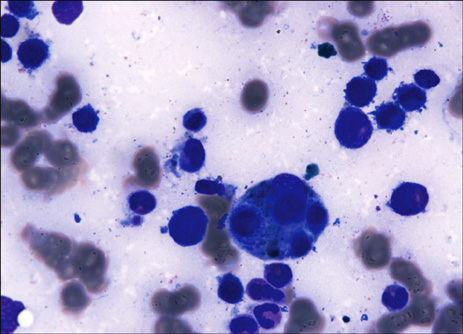Chonnam Med J.
2011 Dec;47(3):173-176. 10.4068/cmj.2011.47.3.173.
Hemophagocytic Lymphohistiocytosis (HLH) Associated with Plasmodium vivax Infection: Case Report and Review of the Literature
- Affiliations
-
- 1Department of Internal Medicine, Seoul St. Mary's Hospital, The Catholic University of Korea College of Medicine, Seoul, Korea. cwp@catholic.ac.kr
- KMID: 2172228
- DOI: http://doi.org/10.4068/cmj.2011.47.3.173
Abstract
- Hemophagocytic lymphohistiocytosis (HLH) is an unusual syndrome characterized by fever, hepatosplenomegaly, cytopenias, hypertriglyceridemia, hypofibrinogenemia, and pathologic findings of hemophagocytosis in the bone marrow and other tissues. HLH may be familial or associated with different types of infections, autoimmune disorders, or malignancies. Infection-associated HLH has been reported in various viral, bacterial, fungal, and parasitic infections, and case reports of parasitic infections implicated in HLH include rare cases from Plasmodium vivax infection, which occasionally affects both military personnel and civilians in Korea. We describe an unusual case of HLH resulting from Plasmodium vivax infection and review the literature. This case suggests that clinical suspicion of HLH is important when P. vivax infection is accompanied by cytopenias. Administration of antimalarial drugs may prevent irreversible end organ damage resulting from P. vivax-associated HLH.
MeSH Terms
Figure
Reference
-
1. Rouphael NG, Talati NJ, Vaughan C, Cunningham K, Moreira R, Gould C. Infections associated with haemophagocytic syndrome. Lancet Infect Dis. 2007. 7:814–822.
Article2. Henter JI, Aricò M, Elinder G, Imashuku S, Janka G. Familial hemophagocytic lymphohistiocytosis. Primary hemophagocytic lymphohistiocytosis. Hematol Oncol Clin North Am. 1998. 12:417–433.3. Henter JI, Horne A, Aricò M, Egeler RM, Filipovich AH, Imashuku S, et al. HLH-2004: diagnostic and therapeutic guidelines for hemophagocytic lymphohistiocytosis. Pediatr Blood Cancer. 2007. 48:124–131.
Article4. Aouba A, Noguera ME, Clauvel JP, Quint L. Haemophagocytic syndrome associated with Plasmodium vivax infection. Br J Haematol. 2000. 108:832–833.5. Park TS, Oh SH, Choi JC, Kim HH, Chang CL, Son HC, et al. Plasmodium vivax malaria complicated by hemophagocytic syndrome in an immunocompetent serviceman. Am J Hematol. 2003. 74:127–130.
Article6. Bae E, Jang S, Park CJ, Chi HS. Plasmodium vivax malaria-associated hemophagocytic lymphohistiocytosis in a young man with pancytopenia and fever. Ann Hematol. 2011. 90:491–492.
Article7. Singh ZN, Rakheja D, Yadav TP, Shome DK. Infection-associated haemophagocytosis: the tropical spectrum. Clin Lab Haematol. 2005. 27:312–315.
Article8. Pahwa R, Singh T, Khurana N. Hemophagocytic syndrome in malaria and kala-azar. Indian J Pathol Microbiol. 2004. 47:348–350.9. Jordan MB, Hildeman D, Kappler J, Marrack P. An animal model of hemophagocytic lymphohistiocytosis (HLH): CD8+ T cells and interferon gamma are essential for the disorder. Blood. 2004. 104:735–743.
Article10. Imashuku S, Kuriyama K, Teramura T, Ishii E, Kinugawa N, Kato M, et al. Requirement for etoposide in the treatment of Epstein-Barr virus-associated hemophagocytic lymphohistiocytosis. J Clin Oncol. 2001. 19:2665–2673.
Article
- Full Text Links
- Actions
-
Cited
- CITED
-
- Close
- Share
- Similar articles
-
- Two Cases of Hemophagocytic Lymphohistiocytosis Following Kikuchi's Disease
- Hemophagocytic Lymphohistiocytosis
- Macrolide-refractory Mycoplasma pneumoniae pneumonia and hemophagocytic lymphohistiocytosis: case report and literature review
- A Case of Death Due to Hemophagocytic Lymphohistiocytosis Accompanied by Scrub Typhus
- A Case of Secondary Precursor B-cell Acute Lymphoblastic Leukemia Occurring after Treatment of Hemophagocytic Lymphohistiocytosis



